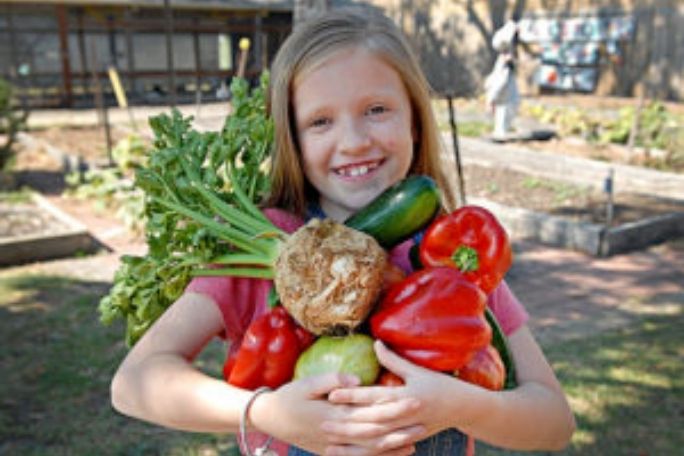Lesson summary
The Enviroweek Green Thumb Action encourages students to create and care for green spaces. Students will be inspired to increase schoolyard biodiversity and care for existing green spaces. This resource is presented in three parts composed of individual activities.
Part 1 – Tune In: Students investigate the things plants need for survival by experimenting with seeds.
Part 2 – Act: Students plan and develop their own Green Thumb Challenge by “greening up” an area of their school or caring for an existing planting site.
Part 3 – Share: Students share their experiences and inspire other to take action.
Learning intentions:
Students will...
- begin to understand what plants need for survival
- begin to take some responsibility for local biodiversity
- plan simple projects for protecting local biodiversity
- communicate the importance of local biodiversity with the wider school community.
Lesson guides and printables
Lesson details
Curriculum mapping
Australian Curriculum content descriptions:
Foundation Science:
- Living things have basic needs, including food and water (ACSSU002)
- Science involves exploring and observing the world using the senses (ACSHE013)
Year 1 Science:
- Living things live in different places where their needs are met (ACSSU211)
- Use a range of methods to sort information, including drawings and provided tables (ACSIS027)
- Represent and communicate observations and ideas in a variety of ways such as oral and written language, drawing and role play (ACSIS029)
Year 2 Science:
- Living things grow, change and have offspring similar to themselves (ACSSU030)
- Represent and communicate observations and ideas in a variety of ways such as oral and written language, drawing and role play (ACSIS042)
- Use a range of methods to sort information, including drawings and provided tables (ACSIS040)
Foundation to Year 2 Visual Arts:
- Explore ideas, experiences, observations and imagination to create visual artworks and design, including considering ideas in artworks by Aboriginal and Torres Strait Islander artists (ACAVAM106)
- Use and experiment with different materials, techniques, technologies and processes to make artworks (ACAVAM107)
- Create and display artworks to communicate ideas to an audience (ACAVAM108)
Year 3 Science:
- Living things can be grouped on the basis of observable features and can be distinguished from non-living things (ACSSU044)
- Use a range of methods including tables and simple column graphs to represent data and to identify patterns and trends (ACSIS057)
- Compare results with predictions, suggesting possible reasons for findings (ACSIS215)
- Represent and communicate ideas and findings in a variety of ways such as diagrams, physical representations and simple reports (ACSIS060)
Year 4 Science:
- Living things, including plants and animals, depend on each other and the environment to survive (ACSSU073)
- Use a range of methods including tables and simple column graphs to represent data and to identify patterns and trends (ACSIS068)
- Compare results with predictions, suggesting possible reasons for findings (ACSIS216)
- Represent and communicate ideas and findings in a variety of ways such as diagrams, physical representations and simple reports (ACSIS071)
Years 3 & 4 Visual Arts:
- Use materials, techniques and processes to explore visual conventions when making artworks (ACAVAM111)
- Present artworks and describe how they have used visual conventions to represent their ideas (ACAVAM112)
Year 5 Science:
- With guidance, plan appropriate investigation methods to answer questions or solve problems (ACSIS086)
- Construct and use a range of representations, including tables and graphs, to represent and describe observations, patterns or relationships in data using digital technologies as appropriate (ACSIS090)
- Compare data with predictions and use as evidence in developing explanations (ACSIS218)
- Suggest improvements to the methods used to investigate a question or solve a problem (ACSIS091)
- Communicate ideas, explanations and processes in a variety of ways, including multi-modal texts (ACSIS093)
Year 6 Science:
- The growth and survival of living things are affected by the physical conditions of their environment (ACSSU094)
- With guidance, plan appropriate investigation methods to answer questions or solve problems (ACSIS103)
- Decide which variable should be changed and measured in fair tests and accurately observe, measure and record data, using digital technologies as appropriate (ACSIS104)
- Construct and use a range of representations, including tables and graphs, to represent and describe observations, patterns or relationships in data using digital technologies as appropriate (ACSIS107)
- Compare data with predictions and use as evidence in developing explanations (ACSIS221)
- Suggest improvements to the methods used to investigate a question or solve a problem (ACSIS108)
- Communicate ideas, explanations and processes in a variety of ways, including multi-modal texts (ACSIS110)
Years 5 & 6 Visual Arts:
- Develop and apply techniques and processes when making their artworks (ACAVAM115)
- Plan the display of artworks to enhance their meaning for an audience (ACAVAM116)
Syllabus Outcomes: STe-4WS, ST1-4WS, ST2-4WS, ST3-4WS, STe-8NE, ST1-10LW, ST2-10LW, ST1-11LW, VAS1.1, VAS1.2, VAS2.1, VAS2.2, VAS3.1, VAS3.2.
General capabilities: Critical and creative thinking.
Cross-curriculum priorities: Sustainability OI2.
Additional info
This is an original Cool.org lesson. Facts and figures in these lessons may have changed since this lesson was published. We always endeavour to update our resources in a timely manner, but if you see an error or issue in our resources please get in touch with us.


Welcome back!
Don't have an account yet?
Log in with:
By signing up to Cool.org you consent and agree to Cool's privacy policy to
store, manage and process your personal information. To read more, please see
our privacy policy here(Opens in new tab).
Create your free Cool.org account.
Many of our resources are free, with an option to upgrade to Cool+ for premium content.
Already have an account?
Sign up with:
By signing up to Cool.org you consent and agree to Cool's privacy policy to
store, manage and process your personal information. To read more, please see
our privacy policy here(Opens in new tab).